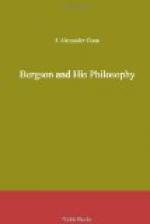Now, from his careful study of the pathological phenomena, manifested in these cases, Bergson draws some very important conclusions in regard to the nature of Memory and its relation to the brain. In 1896, when he brought out his work Matiere et Memoire, in Paris, the general view was against his conclusions and his opinions were ridiculed. By 1910, a marked change had come about and he was able to refer to this in the new introduction.[Footnote: See Bibliography, p. 158.] His view was no longer considered paradoxical. The conception of aphasia, once classical, universally admitted, believed to be unshakeable, had been considerably shaken in that period of fourteen years. Localization, and reference to centres would not, it was found, explain things sufficiently.[Footnote: The work of Pierre Janet was largely influential also in bringing about this change of view.] This involved a too rigid and mechanical conception of the brain as a mere “box,” and Bergson attacks it very forcibly under the name of “the box theory.” “All the arguments,” he says, “from fact which may be invoked in favour of a probable accumulation of memories in the cortical substance, are drawn from local disorders of memory. But if recollections were really deposited in the brain, to definite gaps in memory characteristic lesions of the brain would correspond. Now in those forms of amnesia in which a whole period of our past existence, for example, is abruptly and entirely obliterated from memory, we do not observe any precise cerebral lesion; and on the contrary, in those disorders of memory where cerebral localization is distinct and certain, that is to say, in the different types of aphasia, and in the diseases of visual or auditory recognition, we do not find that certain definite recollections are, as it were, torn from their seat, but that it is the whole faculty of remembering that is more or




